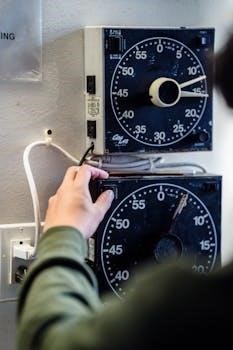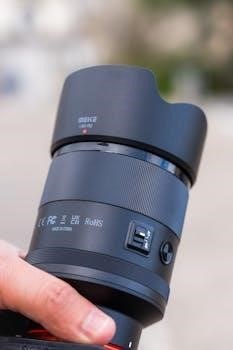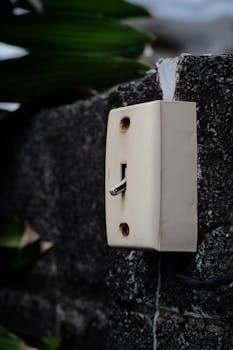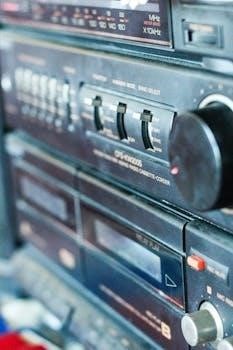
What is a 100 Amp Manual Transfer Switch?
A 100 amp manual transfer switch is a device that allows you to safely switch between power sources, such as utility power and a generator. It is typically used in residential or commercial settings for backup power during outages.
Definition and Purpose
A 100 amp manual transfer switch is a manually operated electrical device that allows users to switch between two power sources⁚ typically, the main utility grid and a backup generator. Its primary purpose is to safely and reliably transfer power during outages, ensuring essential circuits remain operational. This prevents back-feeding, which can be dangerous for utility workers and damage equipment.

Types of 100 Amp Manual Transfer Switches
100 amp manual transfer switches come in various types, including single-phase and three-phase options. They also have different ratings for indoor or outdoor use, and NEMA ratings.
Single-Phase vs. Three-Phase Options
100 amp manual transfer switches are available in single-phase and three-phase configurations. Single-phase is common for residential use, while three-phase is typically found in commercial or industrial settings. Choosing the correct phase depends on the electrical system’s requirements of the building or equipment being powered. Ensure the switch matches the incoming power supply.
Indoor vs. Outdoor Rated Switches
100 amp manual transfer switches are designed for either indoor or outdoor use, indicated by their NEMA rating. Indoor switches are for protected environments, while outdoor-rated switches have enclosures to withstand weather conditions. Outdoor switches often feature NEMA 3R or similar ratings for protection against rain and snow. Selecting the correct switch depends on the installation location.
NEMA Rating Considerations
NEMA ratings, like NEMA 3R, are crucial when choosing a 100 amp manual transfer switch. These ratings specify the environmental protection provided by the enclosure. A NEMA 3R rating indicates protection against rain, sleet, and snow, making it suitable for outdoor installations. Indoor switches may have lower NEMA ratings as they are not exposed to harsh weather. Selecting the correct NEMA rating ensures the switch’s longevity and safe operation.

Installation of a 100 Amp Manual Transfer Switch
Installing a 100 amp manual transfer switch requires careful planning and adherence to electrical codes. It is generally recommended to have it installed by a professional electrician for safety.
Professional Installation Requirements
Professional installation is strongly advised for 100 amp manual transfer switches due to the complexities of electrical wiring and safety regulations. Licensed electricians are familiar with local codes and can ensure the switch is correctly installed, preventing potential hazards. They have the necessary tools and expertise to handle high-amperage connections, ensuring a safe and reliable power transfer system. Incorrect installation may lead to damage or void warranties.
Mounting and Location Guidelines
When installing a 100 amp manual transfer switch, mount it vertically on a rigid, supporting structure. The switch should be installed as close as possible to the electrical loads it will serve, and maintain proper electrical clearance between live parts and grounded metal. Ensure all mounting points are level to avoid switch distortion. Avoid locations with excessive moisture or extreme temperatures, and ensure easy access for operation and maintenance.
Wiring a 100 Amp Manual Transfer Switch
Proper wiring of a 100 amp manual transfer switch is crucial for safety and functionality. Use the correct wire size and ensure compatibility with your system. Pay close attention to neutral and ground bonding.
Wire Size and Compatibility
When wiring a 100 amp manual transfer switch, selecting the correct wire size is essential to handle the electrical load safely. The wire must be compatible with the switch’s terminals and the amperage it will carry. Using undersized wiring can lead to overheating and potentially dangerous situations. Always refer to the manufacturer’s specifications and local electrical codes for proper wire gauge selection, considering both copper and aluminum wire options.
Neutral/Ground Bonding Considerations
Proper neutral/ground bonding is crucial for the safe operation of a 100 amp manual transfer switch. Typically, the neutral and ground are bonded at the main service panel. However, when using a generator as a backup power source, it’s important to ensure that the generator’s neutral is not also bonded to ground if it is already bonded at the main panel. This can create a dangerous parallel path for current and should be avoided to prevent electrical issues and hazards.

Safety Features of a 100 Amp Manual Transfer Switch
100 amp manual transfer switches often include safety features like overcurrent protection, and are UL listed and ANSI certified. These features ensure safe operation and prevent electrical hazards.
Overcurrent Protection
Overcurrent protection in a 100 amp manual transfer switch is crucial for preventing damage to connected equipment and the switch itself. It safeguards against excessive current flow, which can occur during a fault or overload. This protection is typically achieved through the use of circuit breakers or fuses within the transfer switch panel. These devices automatically interrupt the circuit when a dangerous level of current is detected, enhancing safety and reliability.
UL and ANSI Certifications
UL and ANSI certifications are critical for ensuring the safety and reliability of a 100 amp manual transfer switch. These certifications indicate that the switch has been tested and meets established industry standards for safety and performance. UL listing signifies that the product has undergone rigorous testing by Underwriters Laboratories. ANSI certification confirms compliance with standards developed by the American National Standards Institute, providing added assurance of quality and safety for users.
Compatibility with Generators
A 100 amp manual transfer switch is designed to work with generators within a specific wattage range. It is crucial to ensure compatibility with different generator brands for safe operation.
Generator Wattage Range
When selecting a generator to pair with a 100 amp manual transfer switch, it’s essential to consider the wattage range. Typically, these switches are compatible with generators ranging from 3,000 to 25,000 watts. It’s crucial to ensure that the generator’s output falls within the switch’s capacity to prevent overloading and potential damage; Always verify the specific requirements and limitations detailed in both the transfer switch and generator manuals for safe and optimal performance.
Compatibility with Different Generator Brands
A 100 amp manual transfer switch is designed to be versatile, generally working with various generator brands. However, it is crucial to verify compatibility by checking the specifications of both the transfer switch and the generator. Most standard generators, including Generac and others, are suitable, provided their wattage and voltage align with the transfer switch’s ratings. Always refer to the manufacturer’s documentation to ensure seamless and safe integration between different brands.
Operation of a 100 Amp Manual Transfer Switch
Operating a 100 amp manual transfer switch involves physically moving a lever to switch between the utility power and a generator source. This action ensures safe power transfer.
Switching Between Power Sources
A manual transfer switch allows users to switch power sources by manually moving a lever. This process disconnects the building from the utility grid before connecting it to a generator. This manual operation ensures no back-feeding of power into the grid, which can be dangerous. The switch is designed to safely manage the transfer, preventing damage to both the building’s electrical system and the power sources.
Manual Operation Procedures
Operating a 100 amp manual transfer switch involves a straightforward, yet crucial process. First, ensure the generator is off before switching; Then, locate the transfer switch handle and move it to the desired position, either ‘utility’ or ‘generator’. Always check that the switch is fully engaged in the new position. Start the generator and allow it to stabilize. It is essential to consult the specific manual for any unique instructions.

Maintenance of a 100 Amp Manual Transfer Switch
Regular maintenance for a 100 amp manual transfer switch involves checking for loose connections, inspecting for damage, and ensuring proper functioning. This practice is crucial for safety.
Regular Inspection and Cleaning
Regularly inspect your 100 amp manual transfer switch for any signs of wear, damage, or loose connections. Check for corrosion or overheating, and ensure all wiring is securely attached. Cleaning the switch of dust and debris will prevent buildup that could impede performance. It is recommended to perform these inspections at least annually, or before significant weather events that could cause a power outage. This helps ensure reliable operation when you need it most.
Troubleshooting Common Issues
Common issues with a 100 amp manual transfer switch include the inability to switch between power sources, or intermittent power delivery. Check for tripped breakers or blown fuses within the switch or related panels. Verify wiring connections are secure and undamaged. If problems persist consult a qualified electrician, because internal damage may require a professional repair. Always ensure the unit is de-energized before troubleshooting to prevent electrical shock.
Applications of 100 Amp Manual Transfer Switches
100 amp manual transfer switches are suitable for residential, commercial, and small business use. They provide safe backup power for homes, restaurants, small shops, and farms during outages.
Residential Use
For residential applications, a 100 amp manual transfer switch is ideal for homeowners seeking reliable backup power during outages. It allows the homeowner to power essential appliances and circuits using a portable generator, ensuring comfort and safety. This switch helps maintain critical systems like refrigeration, lighting, and heating, providing peace of mind during power disruptions, and it is compatible with generators starting at 5kW.
Commercial Use
In commercial settings, 100 amp manual transfer switches serve crucial roles in maintaining operations during power failures. They are frequently utilized in small businesses, restaurants, telecommunication facilities, and retail shops to ensure continuous power for vital equipment and systems. These switches enable businesses to quickly transition to generator power, minimizing downtime and potential financial losses, and they can power crucial devices.